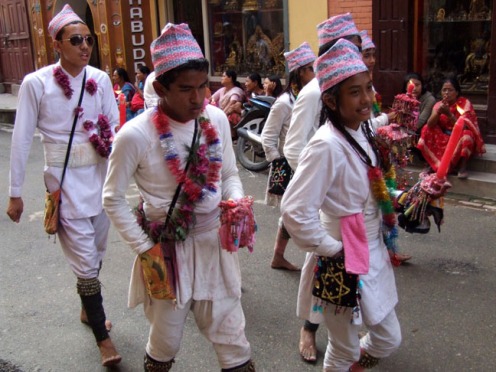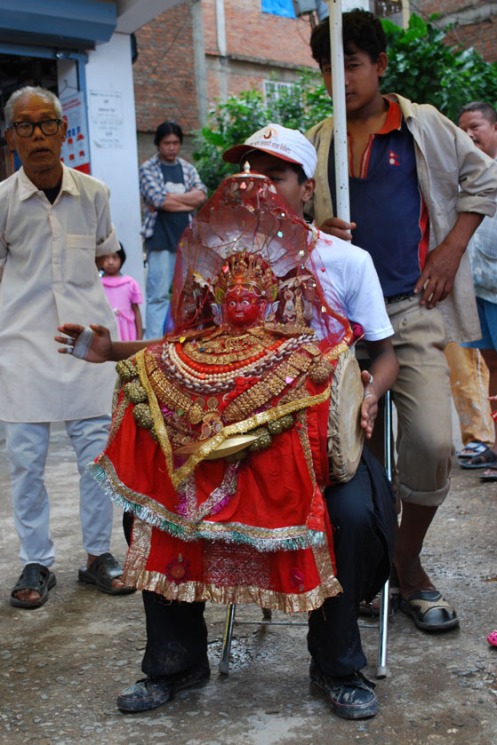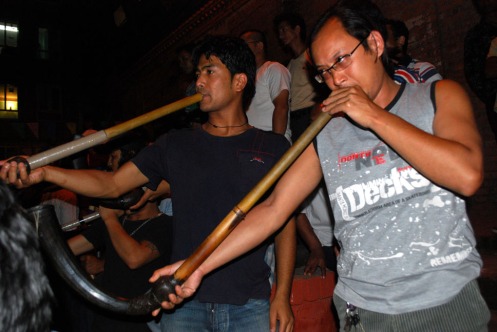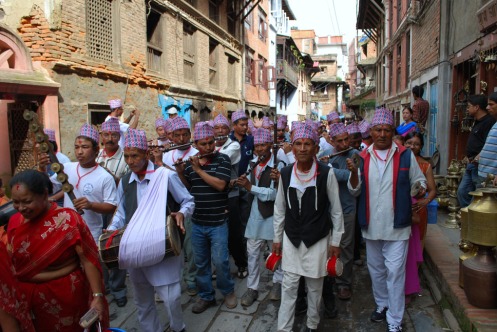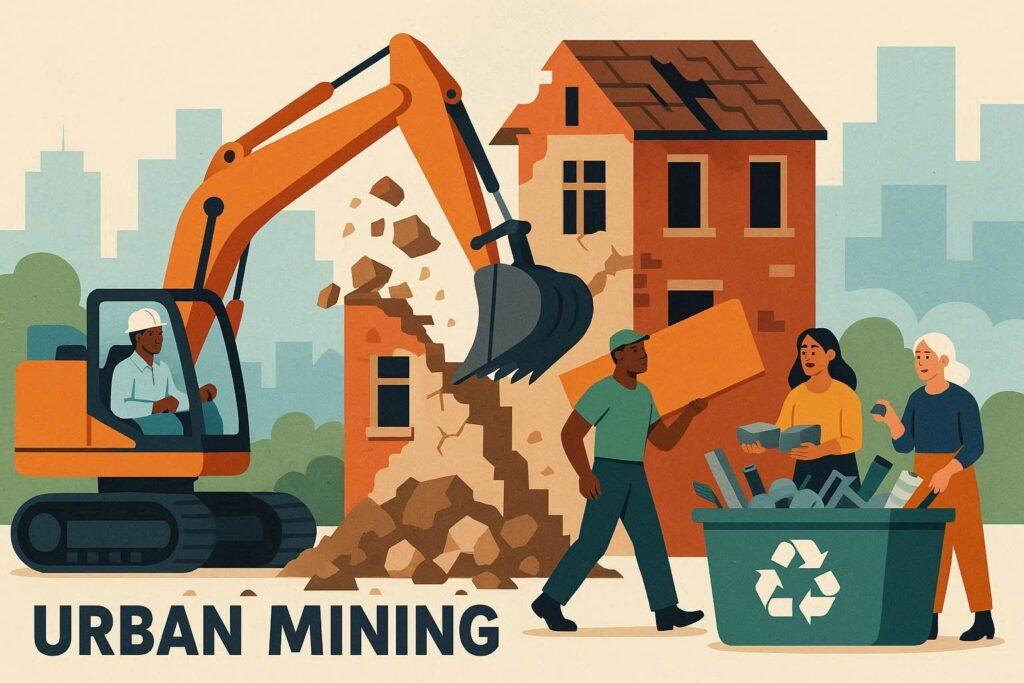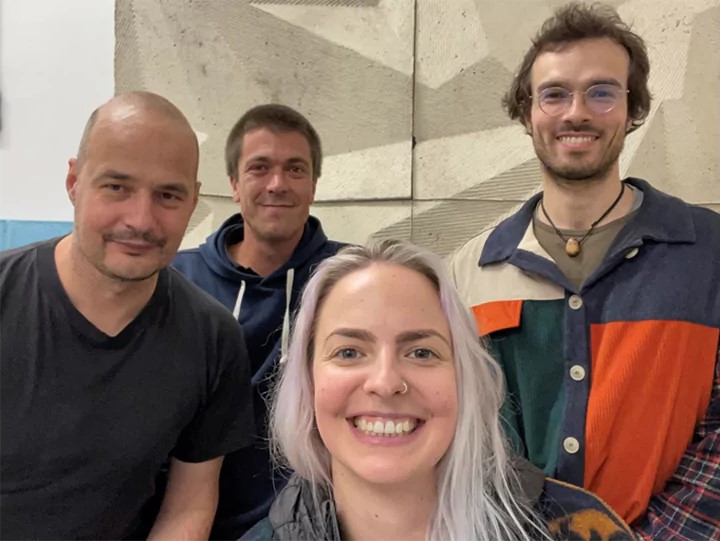In 2008 I was visiting Nepal for some weeks with a group of students from Vienna, Austria. During my stay in Patan I got intrigued in the Newar festival culture and especially in one of this festivals: Nyaku Jatra Mataya. As a student of Social Anthropology and Buddhism Studies I had several good reasons to go deeper into detail and research in this matter. After my Participant Observation – as we Anthropologist call it – of the events connected to the festival organized by the locality of Haugal in the year 2009, I was asked to write this short text, that was first published in their souvenir booklet.
Mataya is one of the main public events during the Buddhist month of Gunla (August-September), two days after the full moon Janai Purnima and one after the Sa Paru festival (Gai Jatra). Only one of traditional ten localities of Patan is responsible to organize Mataya (and the other parts of the festival) in one given year but at the same time, whole the Buddhist infrastructure within Patan’s old city walls is the very basis of this event. This includes every monastic courtyard and all caityas, dharmadhatus and shrines of Buddhist deities on the mazelike route of the procession. No wonder the whole procession takes about twelve hours to accomplish: from early morning until late afternoon plus two hours until everyone got tika (blessing by color powder) by the Bajracarya priests.
Mataya brings together different (caste) groups that do not bother so much about each other during everyday life. Especially buddhamargi (followers of the path of Buddha) participate in the festival but also shivamargi (followers of Shiva) do. The reasons to take part are as divers as the participants: to honor Buddha, to accumulate merit, to show condolence for deceased relatives or to combine spirituality with fun. If someone died within the period of one year, it is seen as a duty that at least one family member joins Mataya – or Sa Paru, the cow festival one day before, depending on the religious background. It is believed that everything that is offered will help the deceased person in the afterlife: rice will feed the person, oil lamps give light, camphor provides pleasant smell etc. This should help, even if the person was already reborn.
It is said that representatives of all eight kinds of beings show up during the big procession to honor Buddha, be it human, divine or demon. Its difficult to depict them all, but some of this special participants hardly can be overlooked. In front of the numerous Jyapu (farmer) music groups dance Yaksa demons. Big groups of Maras (mischievous divines) in colorful costumes show homage to the victorious Buddha while at the same time caricature the Newar lifestyle. Mahadev (Shiva) – sometimes alone or accompanied by seven Rishis (sages) – marks that half of the line of participants has already passed by. And sometimes even the ghosts of king Birendra and his wife show up. So the occasion of Mataya provides a most welcome opportunity to show and roleplay religious beliefs and the traditional worldviews within the social drama of a broadly perceived public event.
Apart from all those supernatural beings, it is the huge number of ordinary humans that fill the lines of this town procession. Beside the young participants in modern clothing, big groups of women in traditional haku patasi dresses leave offerings of rice, sweets, camphor etc. at every basket plate next to a caitya or shrine on the route. But what is so striking about Mataya – especially during early morning, when it is still dark – is the number of participants that show particular effort: big uniform groups walking barefoot and carrying candles, others carrying huge bamboo torches, while the white dressed relatives of deceased ones leave oil lights at every caitya.
It is this aspect of the festival that justifies its name: Mata Ya(tra) – lamp (or lights) procession. But even the folk etymology ma tyah (can’t win) fits very well to the fact, that it was Buddha that was victorious and not the numerous Maras that tried to disturb his mediation under the Bodhi tree shortly before his enlightenment.
Mataya is but one of the two jatras happening on the second day after full moon, the other one is the Nyaku Jatra. As the name of this procession suggests, nyaku (or neku) a wind instrument made from the horn of a buffalo plays an important role. Two musical groups (both from the organizing locality of the whole festival) leave from (and later come back to) the very place where also the bigger procession started. But the musicians’ way is significant shorter and very similar to the route of Sa Paru and most of the other jatras.
The first of the two groups is characterized by the three special damokhin (big double-headed drums) that are decorated during this day as three deities: the blue faced god Bhairab and the red faced goddesses Kali and Mahalakshmi. The two goddesses can be distinguished by the pointy face of Kali. The three drums are accompanied by bhusya (cymbals) and traditional by muhali (wind instrument). Nowadays the muhali is often replaced by trumpet and clarinet, played by professional musicians. Three umbrellas are carried over the damokhin to show respect to the deities.
The second group consists of several subgroups: One are the of horn players, playing a extended smaller horn (neku) and bigger horn (dhulu) made of buffalo horn. The smaller ones always played first, the bigger ones are answering their calls. These are supported by another group of professional trumpet and clarinet players. The biggest subgroup consists of the percussion instruments of the nau baja (nine instruments) ensemble. The name of this ensemble is a bit misleading, if one counts all the drums, cymbals and other instruments they are rather twenty different.
The two groups stop on certain locations, playing special songs different from the standard ones played during marching. Many of this songs are unique to location. Reaching the Durbar Square whole the ensemble give a special performance. All the typical drums are played in short solo performances only accompanied by cymbals and sometimes the trumpets and clarinet. After the accomplishing the rest of the procession route, the musical performance ends at the starting point during the evening hours.
The two jatras may be the central events, but there are other ones that are directly connected to the festival of Nyaku Jatra Mataya: Bogi, several performances of the nau baja ensemble on different locations and finally a Ganesh Puja.
Bogi – the name derives from Buddha Git (song of Buddha) – is the ritual preparation of the Mataya route. Starting at begin of the month Gunla musicians from the organizing locality gather at around 2:00 am and walk along the prescribed route of Mataya until sunrise. The next night they continue from the point the stopped the night before. This is repeated until the whole route is accomplished, what can take up to one week. The main instruments are the two types of horn neku and dhulu accompanied by double-headed drum called dha, cymbals and the muhali substitutes trumpet and clarinet. The leading Bajracarya priests, a second music ensemble of flutes and percussion instruments, participants giving offerings to caityas and shrines and a dhime (drum played with stick) accompanied by cymbals at the very end complete the line.
The Nau Baja ensemble described above also gives special performances at other important (Buddhist) locations of the Kathmandu Valley: on the eve of Janai Purnima at Patan´s Kumbheshvar temple during the moving of the linga (Shiva´s symbol) to the platform in the sacred pond. The day following the lights procession they play at the shrine of Kuranamaya (Matsyendranath) in Bungamati, the next day at the hilltop of Svayambhunath next to the big stupa and on Krishna Jayanti (birthday of Krishna) near his Mandir on Durbar Square in Patan.
Another event connected is especially important for the organizing locality of Nyaku Jatra Mataya: the Ganesh Puja. During this procession the community thanks Ganesh (elephant headed son of Shiva) for the successful accomplishment of the whole festival by offering samay baji, the set of traditional Newar food that is piled up to huge heaps in front of every Ganesh shrine on the route. The long lines of women in the traditional haku patasi dresses, each uniform group bringing similar offerings in their buckets, are sometimes accompanied by men in the complimentary daura saruwal suits, while Bajracarya priests and musicians lead the procession. The last of this offerings are given to Mataya Dyah, a small, mobile caitya. And it is the transfer of the Mataya Dyah from the organizing locality to the one, that is responsible the following year, that marks the end of the events.
